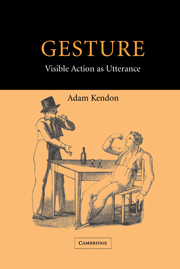Book contents
- Frontmatter
- Contents
- Acknowledgments
- 1 The domain of gesture
- 2 Visible action as gesture
- 3 Western interest in gesture from Classical Antiquity to the eighteenth century
- 4 Four contributions from the nineteenth century: Andrea de Jorio, Edward Tylor, Garrick Mallery and Wilhelm Wundt
- 5 Gesture studies in the twentieth century: recession and return
- 6 Classifying gestures
- 7 Gesture units, gesture phrases and speech
- 8 Deployments of gesture in the utterance
- 9 Gesture and speech in semantic interaction
- 10 Gesture and referential meaning
- 11 On pointing
- 12 Gestures of ‘precision grip’: topic, comment and question markers
- 13 Two gesture families of the open hand
- 14 Gesture without speech: the emergence of kinesic codes
- 15 ‘Gesture’ and ‘sign’ on common ground
- 16 Gesture, culture and the communication economy
- 17 The status of gesture
- Appendix I Transcription conventions
- Appendix II The recordings
- References
- Index
3 - Western interest in gesture from Classical Antiquity to the eighteenth century
Published online by Cambridge University Press: 05 February 2015
- Frontmatter
- Contents
- Acknowledgments
- 1 The domain of gesture
- 2 Visible action as gesture
- 3 Western interest in gesture from Classical Antiquity to the eighteenth century
- 4 Four contributions from the nineteenth century: Andrea de Jorio, Edward Tylor, Garrick Mallery and Wilhelm Wundt
- 5 Gesture studies in the twentieth century: recession and return
- 6 Classifying gestures
- 7 Gesture units, gesture phrases and speech
- 8 Deployments of gesture in the utterance
- 9 Gesture and speech in semantic interaction
- 10 Gesture and referential meaning
- 11 On pointing
- 12 Gestures of ‘precision grip’: topic, comment and question markers
- 13 Two gesture families of the open hand
- 14 Gesture without speech: the emergence of kinesic codes
- 15 ‘Gesture’ and ‘sign’ on common ground
- 16 Gesture, culture and the communication economy
- 17 The status of gesture
- Appendix I Transcription conventions
- Appendix II The recordings
- References
- Index
Summary
Discussion of gesture in Classical Antiquity
In the Western tradition, among the Greeks and, later, the Romans, gesture was recognized as a feature of human expression that, being powerful, must be shaped and regulated in accordance with the aims of creating persuasive or effective discourse. Aristotle saw it as part of the technique used by public orators to sway the feelings of the crowd, but he rather disparaged it, regarding gesture, tone of voice, and other theatrical techniques, as detracting from the ideal of just and proper discourse which, he believed, should require only facts and the principles of reason. Later, in the Roman tradition, these aspects of oratorical technique came to be valued somewhat differently. For example, Cicero discusses gesture and facial expression in his discourses on oratory but, unlike Aristotle, he regarded them as worthy of cultivation. Nevertheless, in his discussion, he emphasizes how gesture and, especially, the face, were to be used to express the feelings that lie behind a discourse. They should be employed in a measured and dignified fashion, not at all in the manner of gesture as used by mimes and actors, whose techniques were regarded as quite different from those of the public orator (Lamedica 1984).
The most complete discussion of gesture from the Roman era is in the eleventh Book of Institutio oratoria (‘Education of the Orator’) by Marcus Fabius Quintilianus, written in the first century AD (Maier-Eichorn 1989, Graf 1993, Aldrete 1999, Dutsch 2003 are recent discussions).
- Type
- Chapter
- Information
- GestureVisible Action as Utterance, pp. 17 - 42Publisher: Cambridge University PressPrint publication year: 2004



